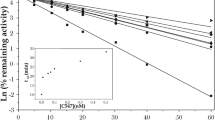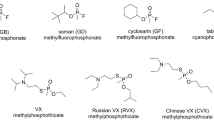The efficiency of benzodiazepines on mouse model of anticholinesterase poisoning was shown. The protective effects of clonazepam and midazolam were observed at high (1 TD50, incoordination) and medium (0.3 TD50) doses and the effects of phenazepam and diazepam were found only at high doses. Midazolam produced the most pronounced protective effect: administration of this drug significantly increased the protective index of atropine+HI-6 combination during poisoning.
Similar content being viewed by others
References
V. S. Genes, Some Simple Methods of Cyber Manufacturing of Data of Diagnostic and Physiological Experiments [in Russian], Moscow, 1967.
V. B. Prozorovskii, Practical Guide for Fast Estimation of Medium Effective Doses and Concentrations of Biologically Active Substances [in Russian], Baikal’sk, 1994.
S. B. Seredenin, T. A. Voronina, and G. G. Neznamov, Phenazepam: 25 Years in Medical Practice [in Russian], Moscow (2007), pp. 126–132.
D. J. Finney, Probit Analysis, 3rd Edition, New York, 1971.
K. Husain, R. A. Ansari, and L. Ferder, Indian. J. Exp. Biol., 48, No. 7, 642–650 (2010).
M. Jokanovic, Toxicol. Lett., 190, No. 2, 107–115 (2009).
G. Lallement, F. Dorandeu, P. Filliat, et al., J. Physiol. Paris, 92, Nos. 5–6, 369–373 (1998).
G. Lallement, J. C. Mestries, A. Privat, et al., Neurotoxicology, 18, No. 3, 851–856 (1997).
J. R. Mikler, C. S. Stewart, S. C. T. Bonhert, et al., Defence Against the Effects of Chemical Hazards, Edinburgh (2007), pp. 15–16.
V. C. Moser, S. M. Chanda, S. R. Mortensen, and S. Padilla, Toxicol. Sci., 46, No. 2, 211–222 (1998).
T. Myhrer, S. Enger, and P. Aas, Basic Clin. Pharmacol. Toxicol., 98, No. 2, 184–191 (2006).
M. Nenner, Biochem. Pharmacol., 23, No. 8, 1255–1262 (1974).
H. Shiotsuki, K. Yoshimi, Y. Shimo, et al., J. Neurosci. Methods, 189, No. 2, 180–185 (2010).
S. Shorvon, Curr. Opin. Neurol., 7, No. 2, 93–95 (1994).
J. Tattersall, Front. Biosci., 14, 3688–3711 (2009).
Author information
Authors and Affiliations
Corresponding author
Additional information
Translated from Byulleten’ Eksperimental’noi Biologii i Meditsiny, Vol. 155, No. 3, pp. 331-336, March, 2013
Rights and permissions
About this article
Cite this article
Yudin, M.A., Subbotina, S.N., Bykov, V.N. et al. Prospects of Using Benzodiazepines in Complex Therapy of Poisonings with Anticholinesterase Agents. Bull Exp Biol Med 155, 354–359 (2013). https://doi.org/10.1007/s10517-013-2152-y
Received:
Published:
Issue Date:
DOI: https://doi.org/10.1007/s10517-013-2152-y




